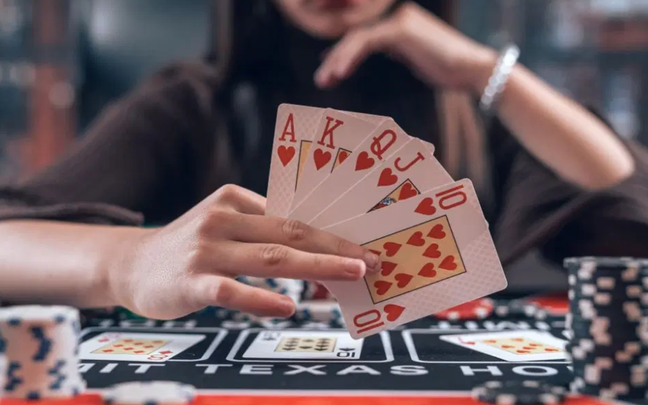The check-raise strategy helps you create surprise and maximize the value of the pot. When used at the right moment, it not only helps increase your chips but also makes it difficult for your opponent to evaluate your hand. This article will help you understand how to use the check-raise strategy effectively, as well as when to apply it in each hand.

The check-raise strategy helps maximize value when you have a strong hand.
What is the check-raise strategy?
The check-raise strategy is one of the most sophisticated and powerful tactics used to put pressure on opponents, maximize profit with strong hands, or force opponents to fold in bluff situations.
It is not only a tactical tool but also a way to demonstrate control and influence over the opponent’s mindset.
A check-raise occurs when you check on the first betting round, allowing your opponent to bet, and then raise with a larger amount within the same betting round. This strategy is typically used on the flop or turn and is less common pre-flop.
The goal of the check-raise strategy can vary depending on the player's strategy, but it generally falls into two main scenarios: maximizing value with a strong hand and bluffing with a weak hand.

The check-raise strategy creates surprise, making it difficult for your opponent to predict your hand.
The Benefits and Timing of Using the Check-Raise Strategy in Poker
The check-raise strategy helps you maximize favorable situations and create pressure on your opponent. When executed subtly, the check-raise can turn what seems like a normal hand into a big win.
However, to use the check-raise strategy effectively, you need to understand its benefits and the right moments to apply it.
Benefits of the Check-Raise Strategy
Maximizing Value with a Strong Hand
When you have a strong hand, such as a set (three of a kind) or two pair on the flop, executing a check-raise is a great way to extract more chips from your opponent.
Your opponent is likely to bet with a medium-strength hand or a bluff, and your raise forces them to make a tough decision. In this case, you’re not only protecting your hand but also maximizing the pot value, creating an opportunity for your opponent to add more chips when they feel their hand is still strong.
Creating Pressure on Your Opponent
One of the greatest benefits of the check-raise strategy is its ability to put pressure on your opponent. When you check, your opponent may feel comfortable and bet with weak hands, assuming you have nothing. However, when you raise immediately after, you force them to reconsider their decision.
This is particularly useful when you don’t have a strong hand but want to bluff, forcing your opponent to fold weak or medium hands. The element of surprise from the check-raise will make them think carefully about their next move.
Controlling the Pace of the Game
The check-raise strategy not only helps you control the hand at a strategic level but also enables you to take control of the overall game.
If you’re playing passively and check continuously, your opponent will feel confident and easily carry out their moves. However, by using the check-raise strategy, you shift from a defensive to an offensive posture, changing the rhythm of the game and forcing your opponent to adjust to your style.
Making It Hard for Your Opponent to Read You
A key factor that makes the check-raise strategy effective is its ability to make it hard for your opponent to read your hand.
If you only use the check-raise with strong hands, your opponent will recognize this and avoid situations like that in the future. However, when you mix in check-raises with well-timed bluffs, you make it difficult for your opponent to predict whether you’re bluffing or holding a strong hand. This increases the chance of them making mistakes and making inaccurate decisions.
When to Use the Check-Raise Strategy
When You Have a Strong Hand
If you have a strong hand, such as a set (three of a kind), two pair, or a completed hand like a flush or straight, applying the check-raise strategy is the best way to maximize your value.
Your opponent may bet with a weaker hand, and you’ll be able to extract more chips from them. However, it’s important to recognize that your opponent may chase the pot with a relatively strong hand or tend to play aggressively.
When You Want to Bluff
The check-raise strategy is not just for strong hands. One of the most common situations is when you want to use the check-raise as a bluff.
For example, if you notice that your opponent tends to make large bets when you check, and you assess that their hand could be weak or they’re just experimenting with a not-so-strong hand, then a check-raise could force them to fold. A successful check-raise bluff can make your opponent discard weak or medium hands they’ve bet on.
When You Want to Protect Your Hand
If you have a hand like a high pair or medium-strength hands, the check-raise strategy can help protect your hand effectively.
For example, if you have a big pair on the flop (like a pair of Aces) and your opponent might be on a strong draw, executing the check-raise strategy forces them to invest more and decide whether they want to continue. This helps protect your hand from strong draws or hands that might beat you on later streets.
When You Have Clear Information on Your Opponent
Reading your opponent is an essential skill in poker and becomes even more crucial when you plan to use strategies like the check-raise.
If you notice that your opponent tends to make large bets when you check, the strategy can capitalize on their tendencies. One of the key things to remember when using the check-raise is ensuring you fully understand your opponent’s behavior. If they don’t often bet with weak hands, a check-raise may not produce the expected results.
The check-raise strategy is a powerful and potentially game-changing tactic in poker, but it requires you to use it with finesse and intelligence.

The check-raise strategy helps you apply pressure on your opponent, forcing them to make a difficult decision.
Using the check-raise strategy correctly will help you not only maximize value with strong hands but also make it difficult for your opponent to predict your moves, putting pressure on them in specific situations.
However, overusing the check-raise strategy or using it recklessly can lead to losing your advantage. Therefore, always stay alert and ensure that you apply the check-raise strategy in the right situations, when you can read your opponent correctly and grasp the rhythm of the game.























